Sleeper retaining walls are versatile structures used to retain soil, prevent erosion, and create level areas․ They combine functionality with aesthetic appeal, offering durable solutions for landscaping needs while integrating seamlessly into outdoor designs․ These walls are constructed using horizontal sleepers, which can be made of timber or concrete, providing both structural support and visual interest․ Their design allows for customization, making them suitable for various applications, from residential gardens to commercial settings․ Proper design and construction ensure stability and longevity, making sleeper walls a practical choice for terrain modification and beautification․
1․1 Definition and Purpose
A sleeper retaining wall is a structural element constructed using horizontal sleepers, typically made of timber or concrete, to retain soil and prevent erosion․ Its primary purpose is to create stable, level areas in landscapes with uneven terrain․ These walls are both functional and aesthetically pleasing, offering a durable solution for gardening, landscaping, and outdoor spaces․ They are versatile, allowing for integration with seating areas and decorative elements, while providing essential support to slopes and terrains, enhancing both safety and visual appeal in residential and commercial settings․
1․2 Benefits of Sleeper Retaining Walls
Sleeper retaining walls offer numerous benefits, including structural support, aesthetic appeal, and versatility․ They provide effective soil retention, preventing erosion and creating stable, usable spaces․ Their design allows for customization, blending seamlessly with landscapes while offering durable, long-lasting solutions․ Sleeper walls are cost-effective, with materials like timber and concrete providing strength and flexibility․ They also enable creative integration of seating and decorative elements, enhancing outdoor spaces․ Additionally, they are environmentally friendly, often using reclaimed materials, making them a practical and sustainable choice for various landscaping needs․
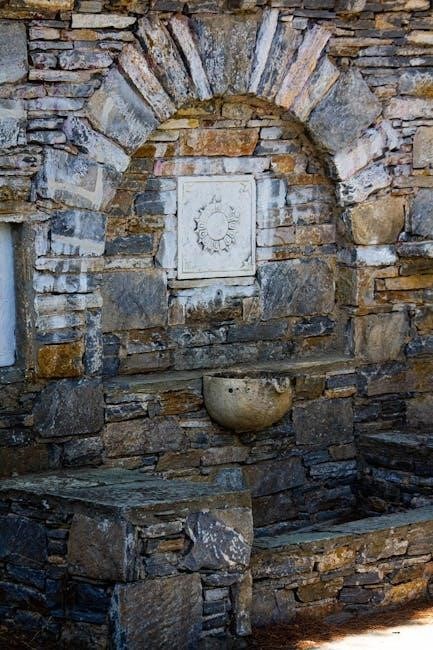
Design Considerations
Proper design ensures structural integrity and functionality․ Key factors include load distribution, material selection, drainage systems, and site-specific conditions․ Expert advice is often required for optimal results․
2․1 Load Calculation and Distribution
Load calculation is critical to ensure the sleeper retaining wall can withstand external forces․ This includes lateral earth pressure, surcharge loads, and any additional weights․ Proper distribution of these loads prevents structural failure․ Engineers use soil mechanics principles to determine pressure distribution behind the wall․ Accurate calculations ensure the wall’s stability and longevity․ Misjudging loads can lead to deformation or collapse, emphasizing the need for precise design and expert consultation․ Regular inspections and maintenance are also essential to monitor load impacts over time․
2․2 Material Selection (Timber vs; Concrete Sleepers)
Material selection is crucial for sleeper retaining walls, with timber and concrete being the most common options․ Timber sleepers are cost-effective, lightweight, and easy to install, making them ideal for smaller walls․ Concrete sleepers, while heavier, offer greater durability and resistance to rot and pests, making them suitable for larger structures․ The choice depends on factors like budget, durability requirements, and aesthetic preferences․ Proper material selection ensures long-term stability and performance of the retaining wall․
2․3 Drainage Systems
Effective drainage is essential for the longevity and stability of sleeper retaining walls․ Properly designed drainage systems prevent water accumulation, which can cause erosion and structural damage․ Key components include geotextiles to filter water, aggregate layers for drainage, and weep holes to relieve hydrostatic pressure․ Installing these elements ensures water is directed away from the wall, maintaining soil stability and preventing failures․ Regular maintenance of drainage systems is critical to uphold the wall’s integrity and performance over time․
2․4 Structural Stability and Reinforcement
Ensuring structural stability is critical for sleeper retaining walls to withstand lateral loads and soil pressure․ Reinforcement materials, such as steel rods or cables, are often embedded to enhance strength and prevent bowing․ The base course must be securely anchored, and sleepers should be tightly connected to vertical posts․ Proper alignment and secure fastening systems are essential to distribute loads evenly․ Regular inspections and maintenance help identify and address potential weaknesses, ensuring long-term stability and structural integrity․
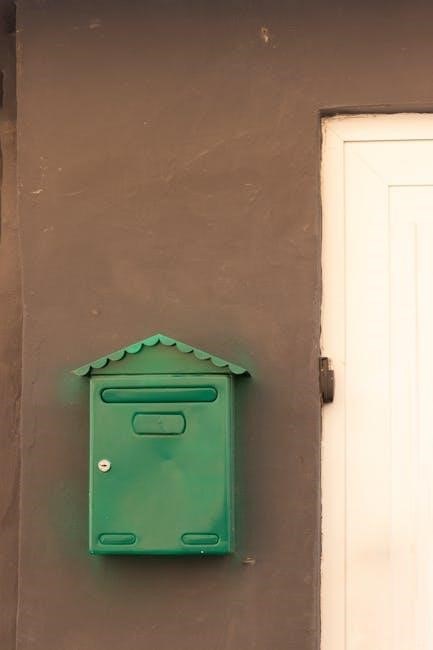
Site Preparation
Site preparation involves land clearing, soil testing, and setting benchmarks for excavation․ Ensuring a stable and level base is crucial for constructing durable sleeper retaining walls․

3․1 Site Assessment and Survey
Site assessment and survey involve evaluating the landscape, identifying obstructions, and determining soil conditions․ This step ensures the wall’s alignment and elevation meet structural requirements․ Surveyors map the area to establish boundary lines and grades, guiding excavation and construction․ Accurate measurements prevent costly errors and ensure compliance with local regulations․ Proper site assessment also identifies potential issues like unstable ground or water tables, crucial for designing a stable sleeper retaining wall system․
3․2 Excavation and Leveling
Excavation involves digging to the required depth for the sleeper wall, ensuring the ground is evenly prepared․ Proper leveling is critical to prevent structural issues․ The site is cleared of debris, and the soil is dug to the specified measurements․ A spirit level or laser level is used to achieve a uniform base․ Compacting the ground ensures stability before laying the sleepers․ Uneven surfaces can lead to wall failure, making precise excavation and leveling essential for a durable sleeper retaining wall․
3․3 Foundation Requirements
A solid foundation is crucial for the stability of a sleeper retaining wall․ It typically consists of a compacted base course of aggregate material or concrete․ The foundation depth varies depending on wall height and soil conditions․ Proper drainage must be ensured to prevent waterlogging․ The base should be level and even, extending slightly beyond the wall’s footprint․ A well-prepared foundation prevents settling and ensures the structure’s longevity, making it a critical step in the construction process․
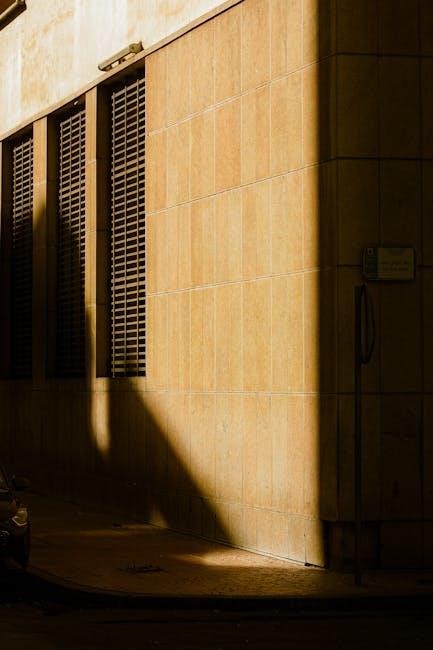
Construction Process
The construction involves systematic steps, including laying sleepers, installing vertical posts, and backfilling․ Proper alignment and drainage are ensured throughout the process for structural integrity․
4․1 Laying the First Course of Sleepers
Laying the first course of sleepers is critical, as it forms the foundation of the retaining wall․ Ensure the site is level and compact․ Mark the area, then place the first sleeper, aligning it with the design plan․ Secure it firmly to prevent movement․ Subsequent courses are built upon this base, so accuracy is key․ Use a spirit level and string lines to maintain proper alignment and ensure the sleepers are evenly spaced for structural integrity․
4․2 Installing Vertical Posts
Vertical posts provide structural support and are typically installed at regular intervals along the sleeper wall․ Dig holes for the posts, ensuring they extend below the base course for stability․ Concrete footings are often used to secure the posts․ Align the posts vertically and anchor them to the sleepers using screws or brackets․ Proper spacing and alignment are essential to ensure the wall’s structural integrity and load distribution․ This step requires precision to maintain the wall’s stability and aesthetic appeal․
4․3 Backfilling and Compaction
Backfilling involves filling the space behind the sleeper wall with soil or aggregate materials, ensuring proper drainage and stability․ Compaction is crucial to prevent settling and ensure the fill material supports the wall’s load․ Use gravel or crushed stone for better drainage and compaction․ Compact in layers using tools like plate compactors or hand tampers to achieve optimal density․ Proper compaction prevents instability and ensures even load distribution․ Compacting in layers helps avoid over-compacting, which can hinder drainage․ This step is vital for the long-term structural integrity of the wall․
Engineering and Certification
Engineering and certification are critical for ensuring sleeper retaining walls meet structural safety and design standards․ Structural engineers oversee plans, and certifications confirm compliance with building codes․
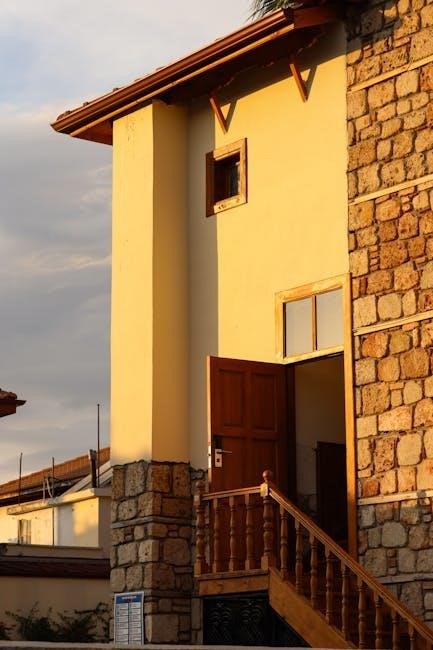
5․1 Role of Structural Engineers
Structural engineers play a vital role in sleeper retaining wall design, ensuring stability and safety․ They assess site conditions, design the wall structure, and select materials․ Engineers calculate loads, soil pressures, and drainage requirements, ensuring compliance with safety standards․ They oversee construction, verify alignments, and certify the wall’s integrity․ Their expertise ensures the wall withstands environmental and structural stresses, providing long-term durability and reliability․
5․2 Compliance with Local Building Codes
Compliance with local building codes is essential for sleeper retaining walls to ensure safety and legality․ Codes dictate design, material, and construction standards, while inspections verify adherence․ Permits are typically required, and non-compliance can lead to fines or removal․ Adhering to codes guarantees the wall’s structural integrity and safety, aligning with community standards and protecting property values․ Proper documentation and approval processes must be followed to avoid legal issues and ensure the wall’s long-term performance and reliability․
5․3 Design Certification and Approvals
Design certification and approvals are critical to validate the structural integrity of sleeper retaining walls․ A certified structural engineer must review and approve the design, ensuring compliance with local codes and standards․ This certification confirms the wall’s safety and performance under expected loads․ Approval documents must be obtained before construction begins, and non-compliance can result in project delays or legal consequences․ Proper certification ensures the design meets safety, durability, and regulatory requirements, providing peace of mind for property owners and stakeholders․
Wall Design Elements
Wall design elements are crucial for both aesthetic appeal and structural integrity․ They include front face details, backface drainage features, base course alignment, and overall stability enhancements․
6․1 Front Face Design
The front face design of a sleeper retaining wall is crucial for both aesthetic and structural purposes․ It involves selecting materials like timber or concrete sleepers, ensuring proper alignment, and achieving a visually appealing finish․ The front face should be designed to withstand external loads while maintaining a clean, professional appearance․ Vertical posts are typically visible, so their spacing and alignment are critical․ Proper finishing techniques, such as staining or sealing, can enhance durability and visual appeal․ Always ensure the design aligns with the wall’s functional requirements and local building standards․
6․2 Backface and Drainage Features
The backface of a sleeper retaining wall is critical for drainage and structural integrity․ A well-designed backface ensures water does not accumulate behind the wall, which can cause pressure buildup and failure․ Drainage features such as geotextiles and aggregate layers help filter water and prevent soil erosion․ Weep holes are often installed to allow water to escape, reducing hydrostatic pressure․ Proper backface construction and drainage systems are essential to maintain the wall’s stability and prevent long-term damage from water infiltration․
6․3 Base Course and Toe Details
The base course is the foundational layer of the sleeper retaining wall, providing stability and distributing loads evenly․ It typically consists of concrete sleepers or steel beams, embedded into the ground to resist uplift forces․ Toe details refer to the front edge of the base, which must be designed to prevent undermining and ensure proper weight transfer․ The base course should be level, compact, and aligned accurately to maintain structural integrity and prevent settling or movement over time․

Drainage and Water Management
Proper drainage and water management are crucial for retaining wall stability․ Effective systems prevent water accumulation, reducing erosion risks and ensuring long-term structural integrity and performance․
7․1 Importance of Proper Drainage
Proper drainage is essential to prevent water accumulation behind the retaining wall, which can lead to increased pressure and potential structural damage․ Without effective drainage, water can erode the soil, weaken the foundation, and compromise the wall’s stability․ Adequate drainage systems ensure that water is directed away, reducing hydrostatic pressure and protecting the structure from long-term damage․ Poor drainage can lead to cracks, shifting, or even collapse, making it a critical factor in retaining wall design and construction․
7․2 Installing Geotextiles and Aggregate
Geotextiles and aggregate are crucial for enhancing drainage and stability in sleeper retaining walls․ Geotextiles, a porous fabric, prevent soil particles from washing away, while aggregate provides a stable, permeable base․ These materials are installed behind the wall, ensuring water flows freely and reduces pressure․ Proper installation involves laying geotextiles first, followed by compacted aggregate, to create a durable and effective drainage system that protects the wall’s integrity and prevents erosion over time․
7․3 Placement of Weep Holes
Weep holes are essential for relieving hydrostatic pressure behind sleeper retaining walls․ They should be placed at regular intervals, typically every 1-2 meters, depending on the wall’s height and site conditions․ Holes are usually drilled in the vertical posts or sleepers at a slight downward angle․ Proper placement ensures water drains freely, preventing erosion and structural damage․ Spacing and height should align with engineering designs to maximize effectiveness and maintain wall stability over time․
Reinforcement and Anchoring
Reinforcement and anchoring systems enhance sleeper wall stability, ensuring structural integrity․ They prevent excessive movement and failure by securely anchoring the wall to the ground or nearby structures․
8․1 Use of Steel Reinforcement
Steel reinforcement is critical in sleeper retaining walls to enhance strength and stability․ It adds tensile strength, resisting bending and shear forces․ Steel bars or mesh are embedded in concrete footings or placed between sleepers to distribute loads evenly․ Proper installation ensures durability and prevents structural failure․ The type and placement of steel reinforcement are specified by structural engineers based on soil conditions and wall height to ensure safety and compliance with design standards․
8․2 Anchoring Systems for Stability
Anchoring systems are essential for ensuring the stability of sleeper retaining walls, especially in unstable soil conditions․ These systems, such as tiebacks or deadmen, anchor the wall to a stable structure or soil behind it․ They prevent lateral movement and distribute forces evenly, enhancing structural integrity․ Anchors are typically installed at specific intervals and depths, as designed by engineers, to counteract soil pressure and ensure long-term stability․ Proper installation is critical to avoid wall failure․
8․3 Ties and Bracing
Ties and bracing are critical components that enhance the structural integrity of sleeper retaining walls․ Steel or timber ties connect the wall to anchors or deadmen, ensuring lateral stability․ Bracing systems, such as cross-beams or diagonal supports, prevent excessive movement and distribute loads evenly․ These elements are typically installed at engineered intervals to provide additional strength and prevent bowing or collapse․ Properly designed ties and bracing ensure the wall remains stable under various soil and load conditions, guaranteeing long-term durability and performance․

Aesthetic and Landscaping Considerations
Sleeper retaining walls offer a visually appealing solution for landscaping․ They can be designed with various materials, textures, and colors to complement surroundings․ Integrating plantings and decorative elements enhances their aesthetic appeal, blending functionality with natural beauty for a harmonious outdoor space․
9․1 Integrating Sleeper Walls into Landscaping
Sleeper retaining walls can seamlessly blend into landscapes by choosing materials that match the surroundings․ Timber sleepers offer a natural, rustic look, while concrete sleepers provide a modern aesthetic․ Staining or painting sleepers can enhance their visual appeal․ Incorporating curved designs or tiered walls adds visual interest․ Plantings on top or in front of the wall can soften the structure, creating a harmonious transition between the built and natural environments․ This integration ensures functionality while maintaining an attractive outdoor space․
9․2 Adding Decorative Features
Enhance the visual appeal of sleeper retaining walls by incorporating decorative elements․ Consider adding lighting, such as solar-powered lights, to highlight the wall’s texture and design․ Paint or stain sleepers to complement surrounding colors․ Embedding decorative stones or tiles into concrete sleepers can create a unique look․ Additionally, attaching features like metal art or carved wood panels can add personality․ These elements transform functional structures into visually striking focal points, blending seamlessly with the landscape while adding character to outdoor spaces․
9․3 Plantings and Greenery
Incorporate plantings and greenery to enhance the beauty and functionality of sleeper retaining walls․ Native plants, shrubs, or ground covers can soften the structure’s appearance, blending it seamlessly into the landscape․ Consider planting in tiers, with taller plants at the base and shorter ones at the top․ Greenery like ivy or moss can also be used to cover sleepers, adding texture and color․ Proper soil preparation and drainage ensure healthy plant growth, creating a harmonious balance between structure and nature․
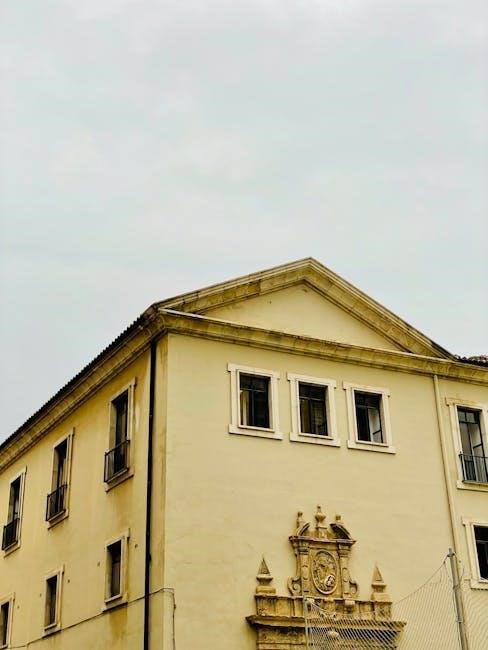
Maintenance and Repair
Regular inspections and repairs are vital for sleeper walls․ Check for cracks, rot, or shifts, and address issues promptly to prevent structural problems․ Durable materials ensure longevity․
10․1 Regular Inspection
Regular inspections are crucial for maintaining the integrity of sleeper retaining walls․ Check for cracks, rot, or shifting sleepers, and inspect drainage systems for blockages․ Vegetation growth near the wall should be monitored, as roots can cause damage․ Seasonal inspections, especially after heavy rainfall or extreme weather, help identify potential issues early․ Use specialized tools or consult professionals for a thorough assessment to ensure the wall remains stable and functional over time․
10․2 Addressing Damage
When damage is detected, assess its extent and prioritize repairs to prevent further deterioration․ For minor cracks, apply appropriate sealants to prevent water infiltration․ If sleepers are shifted or rotten, replace them promptly․ Ensure repairs align with the wall’s structural integrity․ In cases of severe damage, consult professionals to avoid compromising the wall’s stability․ Timely action prevents costly overhauls and maintains safety and functionality․
10․3 Preventative Measures
Regular maintenance is key to extending the lifespan of sleeper retaining walls․ Clean debris and vegetation growth regularly to avoid structural stress․ Apply protective sealants to sleepers to shield them from rot and insect damage․ Monitor drainage systems to ensure proper water flow and prevent erosion․ Address minor issues promptly to avoid escalation․ Implementing these measures helps maintain stability, reduces repair costs, and ensures the wall remains functional and aesthetically pleasing over time․
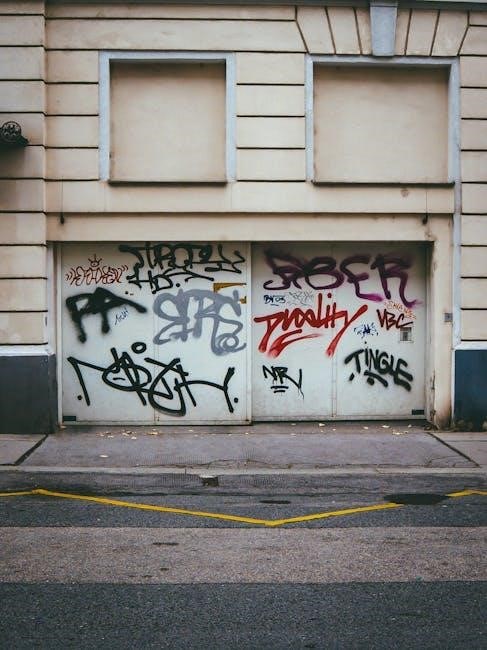
Common Mistakes to Avoid
Common errors include inadequate drainage design, poor material selection, and insufficient structural support․ These mistakes can lead to wall failure and costly repairs․
11․1 Inadequate Drainage
Inadequate drainage is a critical mistake in sleeper retaining wall design․ Poor drainage leads to water buildup, causing hydrostatic pressure and erosion․ Neglecting to install proper geotextiles, insufficient aggregate layers, or incorrect placement of weep holes can result in structural instability․ Water accumulation weakens the wall’s foundation, leading to potential failure․ Proper drainage systems are essential to prevent such issues, ensuring the wall’s longevity and stability․
11․2 Poor Material Selection
Poor material selection can severely compromise a sleeper retaining wall’s performance․ Using untreated timber in high-moisture environments can lead to rot and decay, while low-strength concrete sleepers may crack under load․ Selecting materials unsuitable for the site’s conditions increases the risk of structural failure․ Proper material choice ensures durability and stability, while incorrect choices can lead to costly repairs and safety hazards․ Always consider environmental factors and load requirements when selecting materials for sleeper walls․
11;3 Insufficient Structural Support
Insufficient structural support is a critical mistake in sleeper retaining wall construction․ Without adequate reinforcement, such as steel beams or proper tie-back systems, the wall may bow or collapse under soil pressure․ Inadequate compaction of backfill material can also weaken the structure․ Engineers must ensure that designs account for lateral loads and soil pressure․ Neglecting these factors can lead to costly repairs or even complete failure of the retaining wall over time․